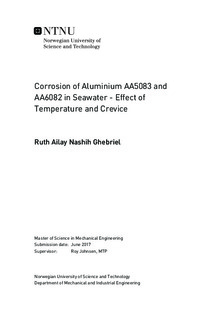Corrosion of Aluminium AA5083 and AA6082 in Seawater - Effect of Temperature and Crevice
Master thesis
Permanent lenke
http://hdl.handle.net/11250/2454574Utgivelsesdato
2017Metadata
Vis full innførselSamlinger
Sammendrag
The results from this study showed that a temperature of 50 degrees Celsius had an effect on both AA5083 and AA6082. The increased temperature increased the corrosion severity on the alloys. This could for instance be seen in the increase of pitting intensity. These results were compared with results from a previous master's thesis written by Ove Nese (NTNU, 2016). The anodic current densities for the galvanic couplings exposed to seawater after 12 weeks of exposure were 2 microA/cm2 and microA/cm2 for G1 (AA6082 and carbon steel S355) and G2 (AA5083 and carbon steel S355), respectively. The required cathodic current densities for the polarised samples exposed at 50 degrees Celsius after 12 weeks exposure were -1,9 microA/cm2 and -2,1 microA/cm2 for the AA6082 and AA5083, respectively. The crevice cell with the 1000 micrometer crevice gap suffered more from corrosion attacks induced by galvanic corrosion than the crevice cell with the 500 micrometer crevice gap. Furthermore, the corrosion attacks were more severe in the middle of the crevice than at the edge of the crevice, which was shown in the SEM images. The potential measured in the middle of the crevice was also about 30 mV vs Ag/AgCl higher than the coupling potential for the crevice cells. The required cathodic current density for the crevice cell in seawater at 10 degrees Celsius after 6 weeks of exposure was -12 microA/cm2.
